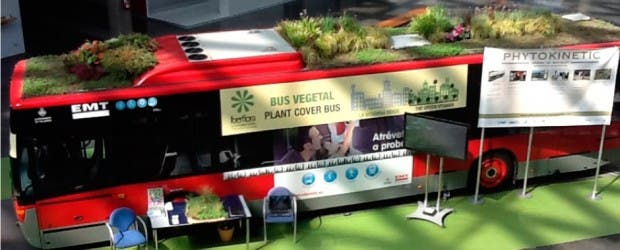Greening the urban environment is not only pleasant to look at – it’s a necessity! But as cool as planting a green roof on a bus is, is this really an efficient way to go at it?
The good
I absolutely love green roofs – and I love innovative public transportation! It makes sense that I’d be a fan of this idea, wouldn’t it?
The matter was discussed in many places ranging from the UK’s (usually green skeptic) Daily Mail to the sustainable design folks at Inhabitat. The idea is to install “air purifying” green roofs on city buses. Here’s how the project’s founder, Marc Granen argues his case:
The lungs of a city must grow at the same rate as its population, but much-needed green areas are not always available. PhytoKinetic has grown out of this supposition, with the goal of delivering a practical and tangible solution. If finding new urban spaces for gardens is problematic, we can use spaces that already exist, such as the roofs of city public transport. Our mission is to expand the garden area in urban areas, increase the absorption of CO2 and give public transport a new ecological and tourist attraction.
The project features some very clever ideas, including irrigating the soil using the condensation from the buses’ own air conditioning systems. The project would reduce the temperature in the bus during the summer, and perhaps raise it very slightly during the winter. But it’s not all good.
The bad
Gardens are heavy – really heavy; and they’re not exactly aerodynamic either. Any additional weight on the bus means that it will consume more fuel. At full water capacity, the system adds 60kg/m2, or roughly the weight of one person every square meter. I wasn’t able to find any calculation on how much fuel this would actually spend, but it’s definitely significant!
Still, one could argue that the bus could only carry a reduced number of people to compensate for that weight, but the fewer people it carries, the lower efficiency it has – public transportation is only efficient and green if it carries many people. Adding such a garden would be a major hurdle here.
So any way you look at it, you either have to spend more fuel, or transport fewer people – both unsustainable options. So technically speaking, the cons outweigh or at least significantly draw back the benefits.
…and the ugly
No, not really. The one thing these gardens have for them is the looks – they really look beautiful, seen both from above and from ground level. Aesthetics and comfort are significant considerations as well, and I’m sure many people would be delighted to see them in their buses.
So when you draw the line, what’s the result? This is certainly a different idea, with some clever implementations, which would have a significant positive aesthetic effect. However, environmentally speaking, my opinion is that there are other, far more efficient and equally pleasant solutions which can be implemented.




